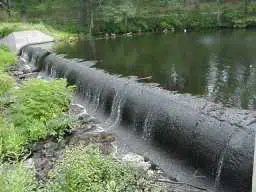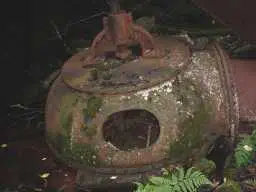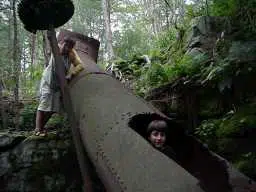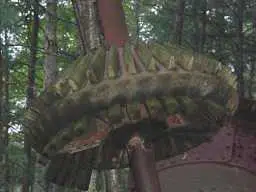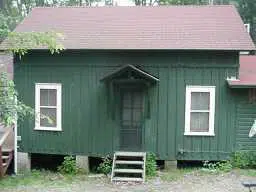WELCOME TO THE GREELEY LUMBER COMPANY WEB PAGE.
The Greeley Lumber Company was formed in 1873 as a partnership of Mahon Godley and Rev. Thomas Taylor. During the formative years, timber was cut by hand and carted to Lackawaxen, Pennsylvania, five miles to the north. Later, the Taylortown Creek and the Shohola Creek were cleared of obstructions allowing logs to float to the hamlet of Shohola, eight miles to the east. During the peak years of operation in the 1880’s the lumber company housed more than 240 workers and the sawmill was in full operation 16 hours per day in the summer and 10 hours per day in the winter.
The Greeley Lumber Company was a pioneer in the use of electricity and a horizontal turbine to run a generator and variable speed motor. The turbine and Comstock pictured below remains along side the Taylortown Creek.
THE TURBINE AND COMSTOCK REMAIN BESIDE THE CREEK.
The twenty-three foot high Comstock was two and one half feet in diameter. The turbine was four and one half feet in diameter, coupled to the generator by two shafts with wooden gears.
THE WOODEN GEAR ON TOP OF THE TURBINE SHAFT.
The beveled transmission gear on top of the remaining drive shaft is in very good condition considering it has not been used in almost 100 years. It is constructed of oak, probably on site from hand hewn timber. The mating gear on the horizontal shaft is long gone. The generator, which was located in the sawmill was removed and used elsewhere. The stone foundation walls of the sawmill rise more than 12 feet in places, although the superstructure has completely washed away.
At full load the generator could provide more than 120 Kilowatts of electricity to power the sawmill. The use of an electric motor to power the cutting blade was desireable because it allowed the blade speed to be easily regulated, and most importantly, stopped quickly. When cutting large logs, the motor would draw more than 100 amperes, pushing the generator near its limit. Excess electricity was used to light the sawmill, Company Store, the Taylor’s home and even a light in their outhouse which is now used as an archery shed at the camp.
THE COMPANY STORE
The company store was constructed in 1879 to provide food and other necessary items to the small but growing logging community of Taylortown. The vertical siding is very apparent on the original section. The Greeley Lumber Company ceased operation around the turn of the century when the area had been fully harvested. The two dams, workers cabins, and sawmill were abandoned. The sawmill was partially destroyed in the flood of 1933. The superstructure was completely destroyed and washed down the creek in during Hurricane Diane in 1955. The Taylor home and the company store, being structurally sound and located above the flood waters, remain in good condition today. Also remaining is the original Taylor two seat, plaster wall outhouse with electric light.
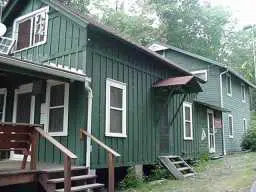
THE COMSTOCK AND GREELEY LAKE DAMS.
The Comstock dam and falls remain in original condition although somewhat deteriorated. The Greeley Lake dam survived the flooding of 1933 and was replaced in 1956 after being destroyed by flooding from Hurricane Diane in August of 1955. The lake dam provided a backup water supply to run the generator during dry spells and also provided the rush of water needed to float timber to the sawmill. The Comstock flume has been filled in except for a short portion near the entrance to the Comstock. Portions of the original lumber camp cabins were salvaged when constructing the cabins of Camp Shohola in 1923. Lake Greeley was also used as an ice supply from the late 1890’s until the mid 1920’s. Although most of the ice was used locally, some was shipped from Lackawaxen or Shohola to larger cities when the demand was high. Only the stone foundation of the icehouse remains.
